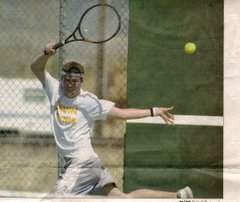Can A Dying Flame Be Re-Kindled?
When Martina Hingis announced in the fall of 2005 that she was making a comeback to women's tennis, the sports world (or at least tennis enthusiasts within the sports world) exploded with excitement.
Hingis, who had held the number one ranking in women's tennis for multiple years, was a both a crafty player and a fiery personality; it seemed she would breathe new life into a tennis game that had lost a little of its fire.
If you remember the US Open in 2005, it featured two stars doing battle in the women's final. Mary Pierce was having a resurgent year, while Kim Clijsters had just claimed her maiden (and what would turn out to be only) Slam. Both these players' successes gave Hingis hope, and when she held her press conference letting us know she was back, she was grinning ear to ear. (Hingis sure wasn't a tennis fasionista in the late '90s, but she didn't need to be. Her game spoke the loudest (and sometimes her attitude). Photo by Globi via Flickr.)
(Hingis sure wasn't a tennis fasionista in the late '90s, but she didn't need to be. Her game spoke the loudest (and sometimes her attitude). Photo by Globi via Flickr.)
And everything seemed to fall in place at the 2006 Australian Open when Hingis made her re-debut. She sparkled with nearly flawless in her first few matches, before falling to Kim Clijsters in the quarterfinals.
Hingis walked away from the tournament quite satisfied, but her loss to Clijsters was foreshadowing for what was to come: defeat at the hands of the bigger ball.
You see, Martina had left the game because it was getting too overwhelming for her, the power was too much. Sure, she said her feet had been hurting, but her forearms and leg muscles ached much more from trying to play backboard tennis against the most powerful women in the world.
Minus quarterfinal performances at the '06 and '07 Australian along with the quarters at last year's French, Hingis has posted just a 7-4 record at the Slams, including two third-round losses at Wimbledon and the USO this year.
In 2001, the year before she retired, Hingis went 60-15 and won three tournaments. 12 of her 15 losses were to players named Capriati, Davenport, Williams, Seles, Clijsters or Mauresmo (a team of 32 Slams).
This year, the Swiss star is just 24-13, with no titles and losses to names like Radwanska, Granville, Mirza, Azarenka and Shuai (0 Slams). It just doesn't look the same. (Hingis is searching for answers she can't find in her stings: her confidence is waning. Photo by Nineeighteen via flickr.)
(Hingis is searching for answers she can't find in her stings: her confidence is waning. Photo by Nineeighteen via flickr.)
Martina's fitness is something that came into question in the late years of her first "career", but Hingis has vowed that she has kept in tip-top shape since being back on the tour, something her physique testifies to.
So why the downfall of the woman who once lost 29 sets in an entire year?
It's first and foremost in the confidence. Hingis' swagger once gave her as much as a set and a half off of opponents just for showing up. But now the 27-year-old is realizing something she never had to question during her early years on tour: she is indeed human.
Secondly, it's in Hingis' inability to change her game. Yes, she did breathe fresh air into a power-laden tour when she returned last year. She did not, however, fix the things that made her game so vulnerably. A weak and spotty serve being the first and the habit of banging from the baseline being the second. In order to execute a game plan, you have to stick to it.
I almost wish that Martina Hingis wouldn't have even tried a comeback whatsoever. I do understand, however, that she had to do it for herself - to see what she could accomplish. Yet it's painful to watch a former champ remain just that, a former champ.
Will she ever return to the status we once marveled (and hated her) for?

1 comment:
off white nike
kobe shoes
kyrie irving shoes
pandora outlet
stone island t shirt
jordan shoes
curry 6
birkin bag
stone island
lebron 18
Post a Comment